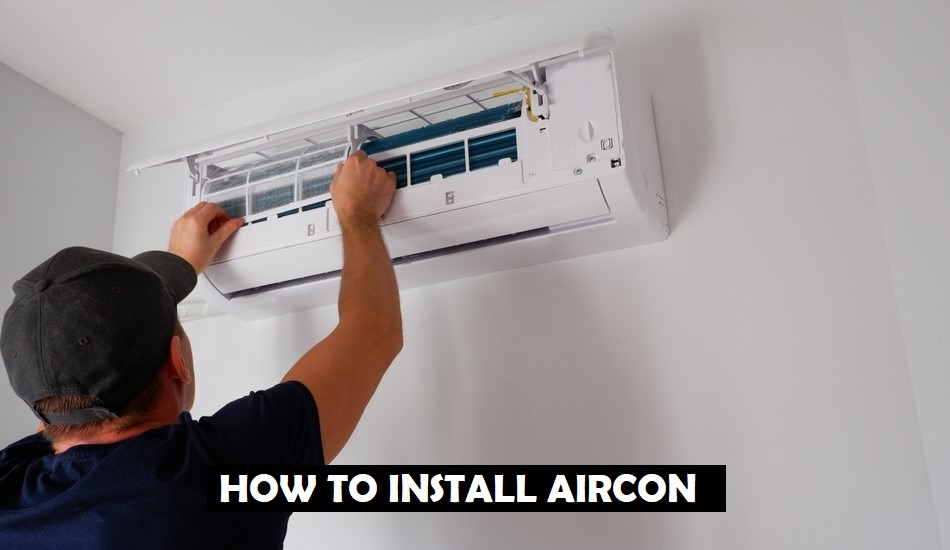As the scorching summer heat becomes unbearable, installing an air conditioner, commonly known as “Aircon,” can provide much-needed relief and comfort. However, the process of air conditioner installation can be daunting, especially if you’re attempting it for the first time. In this comprehensive guide, we will walk you through the steps to install an air conditioner efficiently and effectively.

Understanding the Basics of Air Conditioners
What is an Air Conditioner?
An air conditioner is a cooling system designed to regulate indoor temperature and humidity. It works by removing heat from the air inside a room and transferring it outside, leaving the interior cool and comfortable.
Different Types of Air Conditioners
Before delving into the installation process, it’s essential to understand the various types of air conditioners available, such as window units, split-system units, central air conditioning, and portable air conditioners.
Factors to Consider Before Installation
Determining the Right Size
Choosing the right-sized air conditioner is crucial for optimal cooling performance. An undersized unit may struggle to cool the room, while an oversized one could lead to energy wastage.
Placement of the Air Conditioner
The positioning of the air conditioner plays a significant role in its efficiency. Factors like exposure to direct sunlight, obstructions, and airflow need to be considered for ideal placement.
Energy Efficiency Ratings
Look for air conditioners with high Energy Efficiency Ratio (EER) ratings. A more energy-efficient unit can save you money on electricity bills in the long run.
Step-by-Step Guide to Install an Air Conditioner
Preparing for Installation
Before beginning the installation, gather all the necessary tools and materials. Ensure you have the right bracket for mounting the indoor unit and the appropriate refrigerant lines for connecting the indoor and outdoor units.
Mounting the Indoor Unit
Position the indoor unit on the selected wall following the manufacturer’s guidelines. Use a level to ensure it is perfectly horizontal for optimal drainage.
Installing the Outdoor Unit
Choose a suitable location for the outdoor unit, preferably an area with good airflow and minimal obstructions. Mount the unit on a flat, sturdy surface and secure it firmly.
Connecting the Refrigerant Lines
Carefully connect the refrigerant lines between the indoor and outdoor units. Use a vacuum pump to remove any air and moisture from the lines, ensuring proper cooling efficiency.
Electrical Wiring and Testing
Connect the electrical wires to the respective terminals as instructed in the user manual. Once the connections are secure, turn on the power and test the air conditioner to check for any issues.
Professional Installation vs. DIY
Hiring a Professional
While DIY installation is an option for some, hiring a professional HVAC technician is strongly recommended. Professional installation ensures that the system operates efficiently and avoids potential safety hazards.
Pros and Cons of DIY Installation
DIY installation can save money but might involve risks, especially if you lack experience. Mistakes during installation can lead to costly repairs or void the warranty.
Maintaining Your Air Conditioner
Regular Cleaning and Filter Replacement
Clean the air filters regularly to maintain optimal airflow and cooling efficiency. Clogged filters can reduce the unit’s performance and lead to higher energy consumption.
Annual Maintenance by Professionals
Schedule annual maintenance with a qualified technician to inspect and service your air conditioner. This helps identify potential issues early on and keeps the unit running smoothly.
Troubleshooting Common Issues
Air Conditioner Not Cooling
If your air conditioner is not cooling properly, check the air filters, refrigerant levels, and ensure that the thermostat is set correctly.
Unusual Noises from the Unit
Unusual noises may indicate loose components or a malfunctioning fan motor. Turn off the unit and seek professional assistance if you hear strange sounds.
Leaking or Frozen AC
Leakage or frost formation could be due to a refrigerant leak or blocked drainage. Contact a professional to diagnose and fix the issue promptly.
Air Conditioner Maintenance Tips for Enhanced Efficiency
Using a Programmable Thermostat
A programmable thermostat allows you to set specific temperatures for different times of the day, optimizing energy usage.
Sealing and Insulating Ducts
Sealing and insulating the ducts prevent air leaks, ensuring that cooled air reaches the intended spaces efficiently.
Creating Shade for Outdoor Units
Shielding the outdoor unit from direct sunlight can improve its performance and prolong its lifespan.
Regularly Check and Seal Leaks
Inspect windows and doors for any gaps or leaks that may cause cool air to escape, and seal them to enhance energy efficiency.
Installing an air conditioner can greatly enhance your living space’s comfort during the hot summer months. Whether you choose professional installation or decide to do it yourself, following the correct steps and regular maintenance will ensure efficient and trouble-free cooling for years to come.




